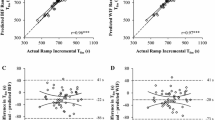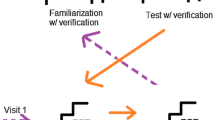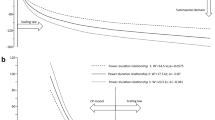Abstract
Purpose
Morton (J Sport Sci 29:307–309, 2011) proposed a model of the peak power attained in ramp protocol (\(\dot{w}_{\text{peak}}\)) that included critical power (CP) and anaerobic capacity as constants, and mean ramp slope (S) as variable. Our hypothesis is that \(\dot{w}_{\text{peak}}\) depends only on S, so that Morton’s model should be applicable in all types of ramps. The aim of this study was to test this hypothesis by validating Morton’s model using stepwise ramp tests with invariant step increment and increasing step duration.
Methods
Sixteen men performed six ramp tests with 25 W increments. Step duration was: 15, 30, 60, 90, 120 and 180 s. Maximal oxygen consumption (\(\dot{V}{\text{O}}_{{ 2 {\text{max}}}}\)) and \(\dot{w}_{\text{peak}}\) were identified as the highest values reached during each test. An Åstrand-type test was also performed. We measured oxygen consumption and ventilatory variables, together with lactate and heart rate.
Results
\(\dot{V}{\text{O}}_{2\hbox{max} }\) was the same in all tests; \(\dot{w}_{\text{peak}}\) was significantly lower the longer the step duration, and all values differed from the maximal power of the Åstrand-type test (\(\dot{w}_{\hbox{max} }\)). Morton’s model yielded an excellent fitting, with mean CP equal to 198.08 ± 37.46 W and anaerobic capacity equal to 16.82 ± 5.69 kJ.
Conclusions
Morton’s model is a good descriptor of the mechanics of ramp tests. Further developments of Morton’s model demonstrated that, whereas \(\dot{w}_{\text{peak}}\) is a protocol-dependent variable, the difference between \(\dot{w}_{\hbox{max} }\) and CP is a constant, so that their values do not depend on the protocol applied.



Similar content being viewed by others
Abbreviations
- a :
-
Whipp’s model constant equal to anaerobic work
- b :
-
Whipp’s model constant equal to maximal mechanical aerobic power
- CP:
-
Critical power
- HR:
-
Heart rate
- IIAT:
-
Incremental intermittent Åstrand-type test
- ISRT:
-
Incremental stepwise ramp test
- [La]b :
-
Blood lactate concentration
- RER:
-
Respiratory exchange ratio
- S :
-
Ramp slope
- t :
-
Time
- T :
-
Time to exhaustion
- T S :
-
Step duration
- \(\dot{V}_{\text{Emax}}\) :
-
Maximal expired ventilation
- \(\dot{V}{\text{O}}_{2}\) :
-
Oxygen consumption
- \(\dot{V}{\text{O}}_{{ 2 {\text{max}}}}\) :
-
Maximal oxygen consumption
- \(W'\) :
-
Morton’s model constant equal to the work carried out to sustain the power above critical power
- W M :
-
Total mechanical work
- \(\dot{w}\) :
-
Power
- \(\dot{w}_{\hbox{max} }\) :
-
Maximal aerobic mechanical power
- \(\dot{w}_{\text{peak}}\) :
-
Peak power of a ramp test
References
Amann M, Subudhi A, Foster C (2004) Influence of testing protocol on ventilatory thresholds and cycling performance. Med Sci Sports Exerc 36:613–622
Åstrand PO, Rodahl K, Dahl HA, Strømme SB (2003) Textbook of work physiology. Physiological bases of exercise, fourth ed. Human Kinetics, Champaign
Bentley DJ, Newell J, Bishop D (2007) Incremental exercise test design and analysis. Implications for performance diagnostics in endurance athletes. Sports Med 37:575–586
Bishop D, Jekins DG, Mackinnon LT (1998) The effect of stage duration on the calculation of peak VO2 during cycle ergometry. J Sci Med Sport 1:171–178
di Prampero PE (1981) Energetics of muscular exercise. Rev Physiol Bioch P 89:143–222
di Prampero PE (1986) The energy cost of human locomotion on land and in water. Int J Sports Med 7:55–72
Duncan GE, Howley ET, Johnson BN (1997) Applicability of VO2max criteria: discontinuous versus continuous protocols. Med Sci Sports Exerc 29:273–278
Fairshter RD, Walters J, Salness K, Fox M, Minh VD, Wilson AF (1983) A comparison of incremental exercise tests during cycle and treadmill ergometry. Med Sci Sports Exerc 15:549–554
Heubert R, Bocquet V, Koralsztein JP, Billat VL (2003) Effets de 4 semaines d’entraînement sur le temps limite à VO2max. Can J Appl Physiol 28:717–736
Heubert RAP, Billat VL, Chasseaing P, Bocquet V, Morton RH, Koralsztein JP, di Prampero PE (2005) Effects of a previous sprint on the parameters of the work-time to exhaustion relationship in high intensity cycling. Int J Sport Med 26:583–592
Howley ET, Bassett DR Jr, Welch HG (1995) Criteria for maximal oxygen uptake: review and commentary. Med Sci Sports Exerc 27:1292–1301
Hughson RL, O’Leary DD, Betik AC, Hebestreit H (2000) Kinetics of oxygen uptake at the onset of exercise near or above peak oxygen uptake. J Appl Physiol 88:1812–1819
Levine BD (2008) VO2max: what do we know, and what do we still need to know? J Physiol 586:25–34
Maksud MG, Coutts KD (1971) Comparison of a continuous and discontinuous graded treadmill test for maximal oxygen uptake. Med Sci Sports Exerc 3:63–65
McArdle WD, Katch FI, Pechar GS (1973) Comparison of continuous and discontinuous treadmill and bicycle tests for max VO2. Med Sci Sports Exerc 3:156–160
McNaughton LR, Roberts S, Bentley BJ (2005) Predicting performance in a short distance cycling time trial: effects of incremental exercise test design. J Strength Cond Res 20:157–161
Monod H, Scherrer J (1965) The work capacity of a synergic muscular group. Ergonomics 8:329–338
Morton RH (1994) Critical power test for ramp exercise. Eur J Appl Physiol 69:435–438
Morton RH (2011) Why peak power is higher at the end of steeper ramps: an explanation based on the “critical power” concept. J Sport Sci 29:307–309
Morton RH, Billat LV (2004) The critical power model for intermittent exercise. Eur J Appl Physiol 91:303–307
Morton RH, Green S, Bishop D, Jekins DG (1997) Ramp and constant power trials produce equivalent critical power estimates. Med Sci Sports Exerc 29:833–836
Myers J, Bellin D (2000) Ramp exercise protocols for clinical and cardiopulmonary exercise testing. Sports Med 30:23–29
Tam E, Rossi H, Moia C, Berardelli C, Rosa G, Capelli C, Ferretti G (2012) Energetics of running in top-level marathon runners from Kenya. Eur J Appl Physiol 112:3797–3806
Taylor HL, Buskirk E, Henschel A (1955) Maximal oxygen uptake as an objective measure of cardiorespiratory performance. J Appl Physiol 8:73–80
Whipp BJ (1994) The bioenergetic and gas exchange basis of exercise testing. Clin Chest Med 15:173–192
Zhang YY, Johnson MC 2nd, Chow N, Wasserman K (1991) Effect of exercise testing protocol on parameters of aerobic function. Med Sci Sports Exerc 23:625–630
Acknowledgments
The authors thank all the volunteers who participated in this study. This research was supported by the Swiss National Science Foundation Grant 32003B_127620 to G. Ferretti.
The authors declare that they have no conflict of interest.
Author information
Authors and Affiliations
Corresponding author
Additional information
Communicated by Jean-René Lacour.
Rights and permissions
About this article
Cite this article
Adami, A., Sivieri, A., Moia, C. et al. Effects of step duration in incremental ramp protocols on peak power and maximal oxygen consumption. Eur J Appl Physiol 113, 2647–2653 (2013). https://doi.org/10.1007/s00421-013-2705-9
Received:
Accepted:
Published:
Issue Date:
DOI: https://doi.org/10.1007/s00421-013-2705-9




